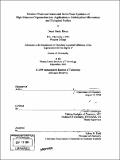| dc.contributor.advisor | Peter H. Seeberger. | en_US |
| dc.contributor.author | Ratner, Daniel Martin, 1977- | en_US |
| dc.contributor.other | Massachusetts Institute of Technology. Dept. of Chemistry. | en_US |
| dc.date.accessioned | 2005-09-27T17:51:40Z | |
| dc.date.available | 2005-09-27T17:51:40Z | |
| dc.date.copyright | 2004 | en_US |
| dc.date.issued | 2004 | en_US |
| dc.identifier.uri | http://hdl.handle.net/1721.1/28701 | |
| dc.description | Thesis (Ph. D.)--Massachusetts Institute of Technology, Dept. of Chemistry, 2004. | en_US |
| dc.description | Vita. | en_US |
| dc.description | Includes bibliographical references. | en_US |
| dc.description.abstract | (cont.) 2G12, cyanovirin-N, and a recently identified anti-HIV protein, scytovirin. | en_US |
| dc.description.abstract | Glycosylation is critical to cellular function in eukaryotic systems. N-linked modification of asparagine residues within nascent proteins is involved in numerous folding and processing pathways. N-linked glycans are also a common feature of viral-associated envelope glycoproteins, including gpl20 and gp41 of the human immunodeficiency virus (HIV-1). These glycans are attractive targets for therapy and prophylaxis due to their numerous roles in HIV infectivity and immunoevasion. This thesis describes the solution-phase synthesis of a series high-mannose type glycans using a linear synthetic approach. The synthetic mannans are used to study the potent anti-HIV microbicide cyanovirin-N, a novel 11 kDa protein isolated from the cyanobacterium (blue-green algae) Nostoc ellipsosporum. These studies established the structural basis for carbohydrate-binding by cyanovirin-N, which is responsible for its HIV inactivating properties. Automated solid-phase synthesis and microfluidic reactors were employed in the development of new technologies for synthetic carbohydrate chemistry. Utilizing a carbohydrate synthesizer, the first automated solid-phase synthesis of the N-linked core pentasaccharide is detailed. In addition, the design, fabrication and application of a microreactor for optimizing the glycosylation reaction is described. Utilizing a novel tri(ethylene glycol) linker with a reactive thiol handle, the fabrication of carbohydrate microarrays is depicted. A panel of oligosaccharides was selected to represent the major structural determinants of high-mannose type glycans on a single microarray. These microarrays were used study the glycan-dependent binding interactions of four gpl20-binding proteins: the dendritic cell lectin DC-SIGN, the antibody | en_US |
| dc.description.statementofresponsibility | by Daniel Martin Ratner. | en_US |
| dc.format.extent | 355 p. | en_US |
| dc.format.extent | 11647654 bytes | |
| dc.format.extent | 11695885 bytes | |
| dc.format.mimetype | application/pdf | |
| dc.format.mimetype | application/pdf | |
| dc.language.iso | en_US | |
| dc.publisher | Massachusetts Institute of Technology | en_US |
| dc.rights | M.I.T. theses are protected by copyright. They may be viewed from this source for any purpose, but reproduction or distribution in any format is prohibited without written permission. See provided URL for inquiries about permission. | en_US |
| dc.rights.uri | http://dspace.mit.edu/handle/1721.1/7582 | |
| dc.subject | Chemistry. | en_US |
| dc.title | Solution-phase and automated solid-phase synthesis of high-mannose oligosaccharides : application to carbohydrate microarrays and biological studies | en_US |
| dc.type | Thesis | en_US |
| dc.description.degree | Ph.D. | en_US |
| dc.contributor.department | Massachusetts Institute of Technology. Department of Chemistry | |
| dc.identifier.oclc | 59133183 | en_US |
